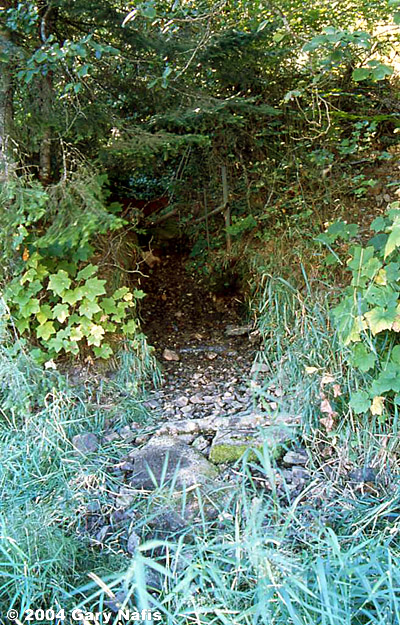Coeur d'Alene salamander (Plethodon idahoensis)
Taxonomy:
Kingdom: Animalia
Phylum: Chordata
Subphylum: Vertebrata
Class: Amphibia
Order: Caudata
Family: Plethodontidae
Subfamily:Plethodontinae
Genus: Plethodon
Species: idahoensis
Description/Identification:
Plethodon idahoensis are small, lungless amphibians that can get up to 10 cm in length. A yellow or gold stripe on the back lies on a black or dark gray ground color. The ventral side is the same black/dark gray color except for a yellow patch on the throat. They look similar to the Long-toed Salamanders except that the Long-toed salamanders lack the yellow throat patch, have longer toes, and lack nasolabial grooves.


Photo by Gary Nafis Photo by Brian Hammond
Distribution:
Coeur d'Alene salamanders are known to be located mainly in northern Idaho and western Montana with a limited distribution southern British Columbia. The Selway drainage marks the southern limit to their Idaho distribution, while in Montana, Sweathouse Creek in the Bitterroot Drainage marks the southern limit there. Copper Creek and the Moyie River drainage make up their northern limit in Idaho, and in Montana the northernmost population is found in the South Fork of the Yaak River. The east and west limits to their distribution are marked by the edges of the Rocky Mountains and about the Idaho-Washington border. In British Columbia, Coeur d'Alene salamanders are known to be located in the waterways draining into the Moyie River, Duck Lake, Kootenay Lake, and also the Columbia River drainage.

Image courtesy of IUCN
Habitat:
Coeur d'Alene salamanders are usually found at elevations from 1000-1500 meters (3300-5000 ft.) in moist seepages, streamside talus areas, and spray zones. Waterfalls provide good habitat for this salamander because the water spraying off keeps the surrounding area moist and wet. Most waterfalls within their range also provide good rock outcroppings within the spray zone for the salamanders to inhabit. When they are not in the immediate vicinity of a creek or streambed, they can be found in areas of deep talus and on well shaded, north-facing slopes with moist soil.


Photo by Gary Nafis Photo by Gary Nafis
Behavior:
These salamanders go into hibernation in November and emerge towards the end of March or early April. They are active above ground throughout April and May, but retreat back underground to aestivate from June-mid-September. They become active again when they return in September until they hibernate again in November. They spend about 75% of their time below ground, making them a very difficult species to study and observe. Two important factors that affect the amount of time they spend above ground are the amount of heat during the day, and the number of days since the last rain. The hotter the temperature, the less time they spend above ground. The same correlation occurs with the absence of rain: the more days its been since it rained, the more time is spent underground.
Predators for the salamanders are generally unknown, but according to WIlson and Simon (1985), American Robins have been observed preying on them. Predation by shrews and possibly other invertebrates is also possible but has not been observed.
Diet:
P. idahoensis feed primarily on aquatic and semi-aquatic invertebrates. These include: dipterans, coleopterans, collembolans, hemipterans, acarinids, homopterans, and hymenopterans.
Reproduction:
Reproduction in P. idahoensis first occurs 3-5 years after birth, with females having a biennial reproductive cycle. Mating occurs in late summer and fall with females sometimes storing the sperm for up to 9 months before actually fertilizing the eggs. An average of 6 eggs are laid from April-May with the young emerging in September. The eggs are presumably laid in damp crevices, but to date, there have not been any nests found in the wild.
Scientific Study:
Since the Coeur d'Alene salamander first began to be studied, there has been controversy about whether or not it is its own species or if it is a subspecies of Plethodon vandykei. In 1999, Albert Wilson, Jr. and John Larsen, Jr. performed a multivariate analysis to analyze the possibilities of interspecific and intraspecific differentiation within the species group presented by Howard et al. (1993). They compared the results from the data they collected to the results of precious analyses and related the patterns of divergence within the species group to forest discontinuities in the Pacific Northwest.
Wilson and Larsen collected 270 salamanders between 1990 and 1992 from 9 different drainages and performed their measurements on live specimens anesthetized with .1% Tricaine Methanesulfonate (MS222). They took 16 measurements and used different statistical analysis programs to see what differences there were between the 9 drainages. Their results showed that there are enough differences between P. vandykei and P. idahoensis to support their notion that forest discontinuities increase the probability that species will diverge when they are separated by these discontinuities. These results not only support their hypothesis, but they will continue to provide support and data for projects currently being investigated and those that will be conducted in the future.
References:
Amphibian Species of the World 5.0, an Online Reference, http://research.amnh.org/herpetology/amphibia, Daryl Frost and the American Museum of Natural History.
AmbhibiaWeb http://amphibiaweb.org, The Regents of the University of California
Behler, J.L. and F.W. King. 1979. Field Guide to Reptiles and Amphibians. National Audubon Society. Alfred Knopf Publisher. New York
California Herps, http://www.californiaherps.com/noncal/northwest/nwsalamanders/pages/p.idahoensis.html, Images by Gary Nafis
Howard, J.H., L.W. Seeb and R.L. Wallace. 1993. Genetic variation and populatoin divergence in the Plethodon vandykei species group. Herpetologica, 39:383-390
IUCN, Conservation International, and NatureServe. 2006. Global Amphibian Assessment. www.globalamphibians.org.
Nafis, G. 2004. http://calphotos.berkeley.edu, 'Coeur d'Alene Salamander,' image. University of California, Berkeley
Tree of Life Project http://tolweb.org, The University of Arizona College of Agriculture and Life Sciences
Wilson, Jr., A.G., Larsen, Jr., J.H. Morphometric Analysis of Salamanders of the Plethodon vandykei Species Group. American Midland Naturalist, Apr99, Vol. 141 Issue 2, p266-276
Wilson, A.G. and E.M. Simon. 1985. Life history notes: Plethodon vandykei idahoensis (Coeur d' Alene salamander). Predation. Herpetological Review 16:111
Page Created by Brian Hammond
Comments (0)
You don't have permission to comment on this page.